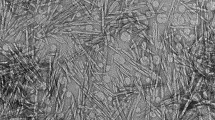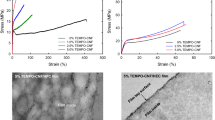Abstract
Nanocellulose is abundant, renewable, biocompatible, and a good candidate as reinforcement agent in nanocomposites; however, its hydrophilicity leads to poor dispersion in hydrophobic polymers. Recently, both in situ polymerization and cellulose surface modification have been used to improve dispersion, but emulsion polymerization is rarely adopted, and when it is, the reinforcement agent is usually cellulose nanocrystal (CNC), with gain in mechanical properties being the main focus of the research. Therefore, this work aims to explore the influence of adding either CNC or microfibrillated cellulose (MFC), both without surface modification, on the mechanical resistance, thermal degradation, and water vapor permeability of poly(vinyl acetate) composites obtained by either in situ emulsion polymerization or mixing. The results showed that despite having similar impacts on thermal and barrier properties, MFC and CNC affect the mechanical properties of their composites differently. Both cause decrease of the thermal degradation rate and do not have a significant impact on water vapor permeability. However, the addition of CNC during synthesis increased composite mechanical resistance significantly while the addition of MFC did not show improvement. Mechanical resistance is also strongly dependent on the procedure used to produce the composites.
Graphic abstract








Similar content being viewed by others
References
Abitbol T, Rivkin A, Cao Y, Nevo Y, Abraham E, Ben-Shalom T, Lapidot S, Shoseyov O (2016) Nanocellulose, a tiny fiber with huge applications. Curr Opin Biotechnol 39:76–88. https://doi.org/10.1016/j.copbio.2016.01.002
ASTM International (2016) ASTM E96/E96M-16: standard test methods for water vapor transmission of materials. West Conshohocken
ASTM International (2018) ASTM D882-18: standard test method for tensile properties of thin plastic sheeting. West Conshohocken
Ballner D, Herzele S, Keckes J, Edler M, Griesser T, Saake B, Liebner F, Potthast A, Paulik C, Gindl-Altmutter W (2016) Lignocellulose nanofiber-reinforced polystyrene produced from composite microspheres obtained in suspension polymerization shows superior mechanical performance. ACS Appl Mater Interface 8:13520–13525. https://doi.org/10.1021/acsami.6b01992
Banerjee M, Sain S, Mukhopadhyay A, Sengupta S, Kar T, Ray D (2014) Surface treatment of cellulose fibers with methylmethacrylate for enhanced properties of in situ polymerized PMMA/cellulose composites. J Appl Polym Sci 131:39808/1–39808/9. https://doi.org/10.1002/app.39808
Ben Mabrouk A, Rei Vilar M, Magnin A, Belgacem MN, Boufi S (2011) Synthesis and characterization of cellulose whiskers/polymer nanocomposite dispersion by mini-emulsion polymerization. J Colloid Interface Sci 363:129–136. https://doi.org/10.1016/j.jcis.2011.07.050
Bouhoute M, Taarji N, Felipe LO, Habibi Y, Kobayashi I, Zahar M, Isoda H, Nakajima M, Neves MA (2021) Microfibrillated cellulose from Arganina spinosa shells as sustainable solid particles for O/W Pickering emulsions. Carbohydr Polym 251:116990/1–116990/10
Cazón P, Velazquez G, Vázquez M (2019) Novel composite films from regenerated cellulose–glycerol–polyvinyl alcohol: mechanical and barrier properties. Food Hydrocoll 89:481–491. https://doi.org/10.1016/j.foodhyd.2018.11.012
Dastjerdi Z, Cranston ED, Dubé MA (2017) Synthesis of poly(n-butyl acrylate/methyl methacrylate)/CNC latex nanocomposites via in situ emulsion polymerization. Macromol React Eng 29:1531–1546. https://doi.org/10.1002/mren.201700013
Dastjerdi Z, Cranston ED, Dubé MA (2018) Pressure sensitive adhesive property modification using cellulose nanocrystals. Int J Adhes Adhes 81:36–42. https://doi.org/10.1016/j.ijadhadh.2017.11.009
Dufresne A (2017) Cellulose nanomaterial reinforced polymer nanocomposites. Curr Opin Colloid Interface Sci 29:1–8. https://doi.org/10.1016/j.cocis.2017.01.004
Elmabrouk AB, Wim T, Dufresne A, Boufi S (2009) Preparation of poly(styrene-co‐hexylacrylate)/cellulose whiskers nanocomposites via miniemulsion polymerization. J Appl Polym Sci 114:2946–2955. https://doi.org/10.1002/app.30886
Fujisawa S, Togawa E, Kuroda K (2017) Nanocellulose-stabilized Pickering emulsions and their applications. Sci Technol Adv Mater 18:959–971. https://doi.org/10.1080/14686996.2017.1401423
Gan PG, Sam ST, Abdullah MFB, Omar MF (2019) Thermal properties of nanocellulose-reinforced composites: a review. J Appl Polym Sci 137:48544/1-48544/14. https://doi.org/10.1002/app.48544
Geng S, Haque MdM-U, Oksman K (2016) Crosslinked poly(vinyl acetate) (PVAc) reinforced with cellulose nanocrystals (CNC): structure and mechanical properties. Compos Sci Technol 126:35–42. https://doi.org/10.1016/j.compscitech.2016.02.013
Geng S, Wei J, Aitomäki Y, Noël M, Oksman K (2018) Well-dispersed cellulose nanocrystals in hydrophobic polymers by in situ polymerization for synthesizing highly reinforced bio-nanocomposites. Nanoscale 10:11797–11807. https://doi.org/10.1039/C7NR09080C
George J, Sabapathi S (2015) Cellulose nanocrystals: synthesis, functional properties, and applications. Nanotechnol Sci Appl 8:45–54. https://doi.org/10.2147/NSA.S64386
Grüneberger F, Huch A, Geiger T, Zimmermann T, Tingaut P (2016) Fibrillated cellulose in heterophase polymerization of nanoscale poly(methyl methacrylate) spheres. Coll Polym Sci 294:1393–1403. https://doi.org/10.1007/s00396-016-3899-2
Habibi Y, Lucia LA, Rojas OJ (2010) Cellulose nanocrystals: chemistry, self-assembly, and applications. Chem Rev 110:3479–3500. https://doi.org/10.1021/cr900339w
Hamou KB, Kaddami H, Dufresne A, Boufi S, Magnin A, Erchiqui F (2018) Impact of TEMPO-oxidization strength on the properties of cellulosenanofibril reinforced polyvinyl acetate nanocomposites. Carbohydr Polym 181:1061–1070. https://doi.org/10.1016/j.carbpol.2017.11.043
Hassan M, Lai TK, Gopakumar DA, Jawaid M, Owolabi FAT, Mistar EM, Alfatah T, Noriman NZ, Haafiz MKM, Abdul Khalil HPS (2019) Micro crystalline bamboo cellulose based seaweed biodegradable composite films for sustainable packaging material. J Polym Environ 27:1602–1612. https://doi.org/10.1007/s10924-019-01457-4
Hoepfner JC, Loos MR, Pezzin SH (2018) Evaluation of thermomechanical properties of polyvinyl butyral nanocomposites reinforced with graphene nanoplatelets synthesized by in situ polymerization. J App Polym Sci 135:46157/1-46157/10. https://doi.org/10.1002/app.46157
Hu Z, Ballinger S, Pelton R, Cranston ED (2015a) Surfactant-enhanced cellulose nanocrystal Pickering emulsions. J Colloid Interface Sci 439:139–148. https://doi.org/10.1016/j.jcis.2014.10.034
Hu Z, Patten T, Pelton R, Cranston ED (2015b) Synergistic stabilization of emulsions and emulsion gels with water-soluble polymers and cellulose nanocrystals. ACS Sustain Chem Eng 3:1023–1031. https://doi.org/10.1021/acssuschemeng.5b00194
Kajtna J, Šebenik U (2017) Novel acrylic/nanocellulose microsphere with improved adhesive properties. Int J Adhes Adhes 74:100–106. https://doi.org/10.1016/j.ijadhadh.2016.11.013
Kargarzadeh H, Mariano M, Huang J, Lin N, Ahmad I, Dufresne A, Thomas S (2017) Recent developments on nanocellulose reinforced polymer nanocomposites: a review. Polymer 132:368–393. https://doi.org/10.1016/j.polymer.2017.09.043
Karimi Shamsabadi M, Moghbeli MR (2017) Cellulose nanocrystals (CNCs) reinforced acrylic pressure-sensitive adhesives (PSAs) prepared via miniemulsion polymerization. Int J Adhes Adhes 78:155–166. https://doi.org/10.1016/j.ijadhadh.2017.06.024
Kedzior SA, Marway HS, Cranston ED (2017) Tailoring cellulose nanocrystal and surfactant behavior in miniemulsion polymerization. Macromolecules 50:2645–2655. https://doi.org/10.1021/acs.macromol.7b00516
Lavoine N, Desloges I, Dufresne A, Bras J (2012) Microfibrillated cellulose—its barrier properties and applications in cellulosic materials: a review. Carbohydr Polym 90:735–764. https://doi.org/10.1016/j.carbpol.2012.05.026
Limousin E, Rafaniello I, Schäfer T, Ballard N, Asua JM (2020) Linking film structure and mechanical properties in nanocomposite films formed from dispersions of cellulose nanocrystals and acrylic latexes. Langmuir 36:2052–2062. https://doi.org/10.1021/acs.langmuir.9b03861
Ma X, Zare Y, Rhee KY (2017) A two-step methodology to study the influence of aggregation/agglomeration of nanoparticles on Young’s modulus of polymer nanocomposites. Nanoscale Res Lett, 12:621/1–621/621/7. https://doi.org/10.1186/s11671-017-2386-0
Mabrouk AB, Kaddami H, Magnin A, Belgacem MN, Dufresne A, Boufi S (2011) Preparation of nanocomposite dispersions based on cellulose whiskers and acrylic copolymer by miniemulsion polymerization: effect of the silane content. Polym Eng Sci 51:62–70. https://doi.org/10.1002/pen.21778
Mabrouk AB, Salon MCB, Magnin A, Belgacem MN, Boufi S (2014) Cellulose-based nanocomposites prepared via mini-emulsion polymerization: understanding the chemistry of the nanocellulose/matrix interface. Colloid Surf A Physicochem Eng Asp 448:1–8. https://doi.org/10.1016/j.colsurfa.2014.01.077
Maiti S, Jayaramudu J, Das K, Reddy SM, Sadiku R, Ray SS, Liu D (2013) Preparation and characterization of nano-cellulose with new shape from different precursor. Carbohydr Polym 98:562–567. https://doi.org/10.1016/j.carbpol.2013.06.029
Mariano M, El Kissi N, Dufresne A (2014) Cellulose nanocrystals and related nanocomposites: review of some properties and challenges. J Polym Sci B Polym Phys 52:791–806. https://doi.org/10.1002/polb.23490
Nechyporchuk O, Belgacem MN, Bras J (2016) Production of cellulose nanofibrils: a review of recent advances. Ind Crops Prod 93:2–25. https://doi.org/10.1016/j.indcrop.2016.02.016
Nogueira T, Botan R, Wypych F, Lona L (2011) Study of thermal and mechanical properties of PMMA/LDHs nanocomposites obtained by in situ bulk polymerization. Compos Part A Appl Sci Manuf 42:1025–1030. https://doi.org/10.1016/j.compositesa.2011.04.006
Oksman K, Aitomäki Y, Mathew AP, Siqueira G, Zhou Q, Butylina S, Tanpichai S, Zhou X, Hooshmand S (2016) Review of the recent developments in cellulose nanocomposite processing. Compos Part A Appl Sci Manuf 83:2–18. https://doi.org/10.1016/j.compositesa.2015.10.041
Ouzas A, Niinivaara E, Cranston ED, Dubé MA (2018) In situ semibatch emulsion polymerization of 2-ethyl hexyl acrylate/n‐butyl acrylate/methyl methacrylate/cellulose nanocrystal nanocomposites for adhesive applications. Macromol React Eng 12:1700068/1-1700068/10. https://doi.org/10.1002/mren.201700068
Pakdel AS, Gabriel V, Berry RM, Fraschini C, Cranston ED, Dubé MA (2020) A sequential design approach for in situ incorporation of cellulose nanocrystals in emulsion-based pressure sensitive adhesives. Cellulose. https://doi.org/10.1007/s10570-020-03060-6
Roohani M, Habibi Y, Belgacem NM, Ebrahim G, Karimi AN, Dufresne A (2008) Cellulose whiskers reinforced polyvinyl alcohol copolymers nanocomposites. Eur Polym J 44:2489–2498. https://doi.org/10.1016/j.eurpolymj.2008.05.024
Sain S, Bose M, Ray D, Mukhopadhyay A, Sengupta S, Kar T, Ennis CJ, Rahman PK, Misra M (2013) A comparative study of polymethylmethacrylate/cellulose nanocomposites prepared by in situ polymerization and ex situ dispersion techniques. J Reinf Plast Compos 32:147–159. https://doi.org/10.1177/0731684412449699
Sain S, Ray D, Mukhopadhyay A (2015) Improved mechanical and moisture resistance property of in situ polymerized transparent PMMA/cellulose composites. Polym Compos 36:1748–1758. https://doi.org/10.1002/pc.23102
Shankar S, Rhim JW (2016) Preparation of nanocellulose from micro-crystalline cellulose: the effect on the performance and properties of agar-based composite films. Carbohydr Polym 135:18–26. https://doi.org/10.1016/j.carbpol.2015.08.082
Tang J, Lee MFX, Zhang W, Zhao B, Berry RM, Tam KC (2014) Dual responsive pickering emulsion stabilized by poly[2-(dimethylamino)ethyl methacrylate]. Grafted Cellul Nanocryst Biomacromol 15:3052–3060. https://doi.org/10.1021/bm500663w
Yamak HB (2013) Emulsion polymerization—effects of polymerization variables on the properties of vinyl acetate based emulsion polymers. In: Yilmaz F (ed) Polymer science. Intech Open. https://doi.org/10.5772/51498
Yan Y, Herzele S, Mahendran RA, Edler M, Griesser T, Saake B, Li J, Gindl-Altmutter W (2016) Microfibrillated lignocellulose enables the suspension-polymerisation of unsaturated polyester resin for novel composite applications. Polymers 8:255/1–255/11. https://doi.org/10.3390/polym8070255
Yu Q, Yang W, Wang Q, Dong W, Du M, Ma P (2019) Functionalization of cellulose nanocrystals with γ-MPS and its effect on the adhesive behavior of acrylic pressure sensitive adhesives. Carbohydr Polym 217:168–177. https://doi.org/10.1016/j.carbpol.2019.04.049
Acknowledgments
The authors are grateful to São Paulo Research Foundation—FAPESP (Grant 2016/18709-4 and 2018/12831-8) for financial support and Suzano Pulp and Paper for the kind donation of MFC. The authors also thank LNNano—Brazilian Nanotechnology National Laboratory, CNPEM/MCTIC for the technical support during the atomic force microscopy work and Espaço da Escrita—Pró-Reitoria de Pesquisa—UNICAMP—for the language services provided.
Funding
São Paulo Research Foundation—FAPESP (Grants 2016/18709-4 and 2018/12831-8).
Author information
Authors and Affiliations
Contributions
The manuscript was written with contributions of all authors. All authors have given approval to the final version of the manuscript. All authors contributed equally.
Corresponding author
Ethics declarations
Conflict of interest
The authors declare that they have no conflict of interest.
Ethical approval
The authors declare the research did not involve either human participation or animal testing.
Additional information
Publisher’s note
Springer Nature remains neutral with regard to jurisdictional claims in published maps and institutional affiliations.
Supplementary Information
Below is the link to the supplementary information
Rights and permissions
About this article
Cite this article
Nozaki, A.P.M., Lona, L.M.F. Comparison between cellulose nanocrystal and microfibrillated cellulose as reinforcement of poly(vinyl acetate) composites obtained by either in situ emulsion polymerization or a simple mixing technique. Cellulose 28, 2273–2286 (2021). https://doi.org/10.1007/s10570-021-03691-3
Received:
Accepted:
Published:
Issue Date:
DOI: https://doi.org/10.1007/s10570-021-03691-3




